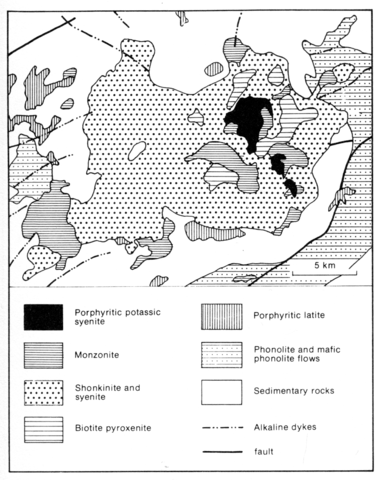stripes
The Rocky Boy stock is the largest and most complex of the numerous intrusions lying along the central, east-west-trending arch of the Bearpaw Mountains (No. 25). It covers over 30 km2, takes an approximately circular form and includes six major rock groups which from oldest to youngest are as follows: (1) biotite pyroxenite containing clinopyroxene and biotite which vary from 10:1 to 1:1, and with less than 10% apatite, K-feldspar, plagioclase, olivine and sulphides. These rocks are transitional to: (2) shonkinites and related syenitic rocks which vary from mesocratic varieties with more than 40% mafic minerals to leucocratic syenites. They all contain K-feldspar, pyroxene and augite plus or minus olivine, plagioclase, nepheline, psuedoleucite, apatite, analcime and interstitial quartz; (3) monzonite and quartz monzonite; (4) nepheline-aegirine syenite and related dykes and pegmatites; (5) porphyritic potassic syenite and related dykes together with silicate-carbonate-sulphide veins (carbonatites); and (6) dykes of mafic analcime phonolite. Complex nepheline syenite pegmatites are widespread and those on Elk Peak have been described by Pecora (1962). In another area, Big Sandy Creek, a collar of nepheline syenite occurs around a plug of sericitized cancrinite syenite. The plug is heavily fractured with numerous veins and disseminations of calcite and sulphides. Silicocarbonatite dykes and stockworks consisting of orthoclase, biotite, calcite, pyrrhotine and pyrite cut the plug and adjacent shonkinite (Pecora, 1962). Isotopic data for sulphur in pyrite from the carbonatite are available (Mitchell and Krouse, 1975). Sr isotope data will be found in Powell and Bell (1970). A pseudoleucite tinguaite has been described in some detail by Zies and Chayes (1960).
HEARN, B.C. 1976. Geologic and tectonic maps of the Bearpaw Mountains area, north-central Montana. United States Geological Survey, Miscellaneous Investigation Series Map I-919.
MITCHELL, R.H. and KROUSE, H.R. 1975. Sulphur isotope geochemistry of carbonatites. Geochimica et Cosmochimica Acta, 39: 1505-15.
PECORA, W.T. 1962. Carbonatite problem in the Bearpaw Mountains, Montana. Geological Society of America, Buddington Volume: 83-104.
PECORA, W.T. et al. 1957. Preliminary geologic map of the Warrick Quadrangle, Bearpaw Mountains, Montana. United States Geological Survey, Miscellaneous Geological Investigations Map: I-237.
POWELL, J.L. and BELL, K. 1970. Strontium isotopic studies of alkalic rocks: localities from Australia, Spain and the western United States. Contributions to MIneralogy and Petrology, 27: 1-10.
ZIES, E.G. and CHAYES, F. 1960. Pseudoleucite in a tinguaite from the Bearpaw Mountains, Montana. Journal of Petrology, 1: 86-98

